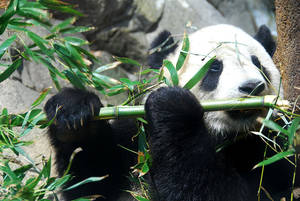Myth: Giant pandas have no sex drive
Interview with
It's mythconception time, and as spring - and maybe love - is in the air, Kat Arney has been finding  out if giant pandas just don't fancy it.
out if giant pandas just don't fancy it.
Kat - Easter, or rather springtime, has been associated with fertility in human culture for many thousands of years. It's not for nothing that we have Easter bunnies and eggs, and the arrival of longer, warmer days is guaranteed to get the sap rising. But while bunnies are often said to have no problems in the reproductive department, giant pandas are allegedly terrible at romance - which apparently explains their poor track record at producing baby pandas.
But a new study from US-based conservation researchers working at the Chengdu Giant Panda Breeding centre in China suggests that this might not be true: pandas do enjoy getting frisky, but only if they actually fancy the other panda in the partnership.
Thanks to poaching and destruction of their natural habitat, giant pandas are an endangered species, with just a couple of thousand left in the wild. The only hope to save the pandas is to breed them in captivity, but although the Chinese breeding centre does manage to churn out super-cute baby pandas on a fairly regular basis, this hasn't been quite the roaring success that researchers might have hoped. And panda pairs in zoos seem to be extremely reluctant to get down to it - as witnessed by the rollercoaster of excitement and disappointment around Tian Tian, Edinburgh zoo's female panda and her possible pregnancies.
When breeding giant pandas in captivity, conservationists tend to try and pair up animals with the lowest levels of genetic similarity or relatedness, to try and avoid inbreeding. But researcher Meghan Martin-Wintle noticed that if a female panda at the Chengdu centre was given the choice of two males, one of which with 'good' different genes and one with more similar genes, she tended to ignore the genetically ideal male and lavish her affections on the other one.
And if she was encouraged to breed with the genetically preferable male, they either didn't manage to get it on, or she didn't manage to get pregnant. But if she was allowed to get up close and personal with the panda she fancied the most, the female was twice as likely to give birth to a cub. And if the attraction was mutual, there was an impressive 80 per cent chance that love would be in the air, with an equally high success rate in producing cubs.
There are other factors at play here too, including whether the pandas had been hand-reared by humans, along with their age and size - it turns out that being a larger, older male gives you a better chance of becoming a panda dad.
So it seems that the pandas and their sex lives have been unfairly maligned by the media. It turns out that they're just like the rest of us: if you want to get frisky, it helps if you fancy the other party - or panda.
- Previous The great fly gender divide
- Next DNA origami!










Comments
Add a comment